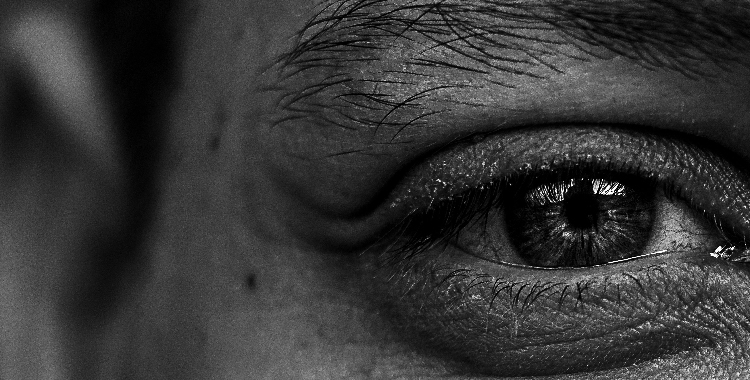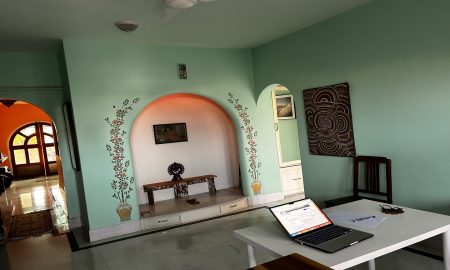The restoration of sight is nothing short of miraculous. The most treasured of our senses, sight helped the first humans differentiate safe from unsafe food, and to stare at the stars in wonder, as we do. Sight helps us lay down new memories. So, when my husband, Fran, learned that his failing eyesight was due to cloudy lenses—called cataracts—that could be replaced in a relative blink of an eye, we were both quietly thrilled. For a year, he’d had to pull a chair close to the TV to watch sports. His squash ranking slipped as challengers caught wind. And with the bright horizon beckoning, last summer we mainly tacked back and forth in Nahant Bay. More seriously, he’d been having trouble lately seeing street signs from behind the wheel.
As on a camera, the lenses in our eyes are focusing devices. Without them, whatever is seen by the light of day is soup. Other senses supposedly take over, and can also be sensational: the scent of rutted earth in mud season; the prehistoric echo of a loon; the sweet, relaxing taste of melted chocolate. Yet sight is the sense that people fear losing most. A recent study of hearing- and sight-impaired adults found that impaired sight alone can drive otherwise healthy people to thoughts of suicide. I was stunned to realize that the procedure Fran was about to undergo would not only make him a safe driver, but would potentially save his life.
On the morning of his first eye surgery, we left our suburb before dawn. Near the Tobin Bridge, the sun shimmied in the sea to the east, the top third of the Constitution’s three black masts visible above the stone rowhouses in Charlestown. Across the way, Bunker Hill’s streets were zippered with refurbished tenements clad in pale vinyl siding. Up and around the curved ramp, the twin upside down Y towers of the Zakim bridge hove into view, its white cable stays arranged like harp strings. The sight of it prompted a memory of Mother’s Day in 2002, when the City of Boston allowed a quarter of a million people to walk across the bridge before its official opening. In the picture Fran took, our three grade-school guys are dressed in primary-colored raincoats and holding close to my hands, arms, body.
I pulled into the dark parking garage, and we found the elevator. While Fran registered with the nurse, I gazed out a window at the Charles River flowing beneath the salt and pepper bridge connects Boston to Cambridge. Years ago—another lifetime, really—I lived a few blocks north where the sign said You’d be Home Now if You Lived Here. Seeing the blue ribbon in the morning sun brought back an odd memory of the art deco wallpaper in my 21st floor apartment. I tried to get a friend to sublet it when I moved to New York, but her fiancée couldn’t stand it.
Fran joined me in the waiting room, ironically stocked with impressive magazines. I picked up National Geographic and The Atlantic, undecided. A nurse called me over to demo the patient update system, a wall-sized board like one you’d see at a racetrack. Colored dots represented the patient’s progress through prep, surgery, post-op, and recovery. She then excused me for ninety minutes, at which time I would return to drive my one-eyed pirate home. In the morning, we would drive back to a satellite office in the Longwood area, where the bandage would be removed. I bid best wishes to Fran, ditched the magazines, and went outside.
Ninety minutes would barely be enough for a walk to the Public Garden and back. Across busy Cambridge St., I slipped into Beacon Hill for a hike up the jaggy sidewalk. Half way up the second block, I paused to (catch my breath and) notice the cobblestones in the street. Further on, the carved wooden doors of stone mansions, the massive yellow backside of the Massachusetts State House, the stunning architecture on Mt. Vernon St. It was quiet; no trucks or sirens. Beyond the brass Keep Out sign on an iron gate, a white bistro table and two vacant chairs had been placed on a strip of green grass. I paused to let the image stoke my imagination.
Down the hill, Charles St. was a real-life Cheers, with well-provisioned shops for fresh produce and liquor, pharmaceuticals, restoration hardware, free-trade coffee, and of course, real estate. Yes, I paused again. Monthly rent for a one-bedroom? $2,500. That’s way more than our mortgage on a five bedroom—granted, two are in the attic—four-square colonial with a one-car garage and a level back yard. My legs pumping, I calculated the annual lease: $30,000. The clock was ticking. What I needed most was coffee.
Inside the nearest bakery, I inhaled the hygge aroma of baked goods while my eyes adjusted from the sunny sidewalk to cool taupe walls. Two other customers came and went while I tried to make sense of the specialty board. Finally, I asked for a regular coffee and a raspberry turnover. At a pub table, I found the Beacon Hill Times. The lead story was a travel piece about Portsmouth, N.H., my old stomping grounds after college. The synchronicity was sublime. I flicked buttery turnover flakes from my sweater, glad I could see them. Refreshed, I took one last glance toward the ducklings and returned to fetch Fran.
***
Once I got over the initial squeamishness and started to read about it, I learned that Fran was in a good place on the cataract timeline. Because sight is so vital, attempts to correct cataracts were among the first medical procedures documented, in the 5th century B.C.E. The cutting edge of technology at the time was a technique called Couching, in which a blunt object is used to strike the eye with enough force to break the lens free from the string-like zonules that suspend it, like trampoline springs, in the eyeball. The freed lens then migrates into the jelly-like vitreous through which light passes in the eye, restoring limited but completely unfocused vision.
Centuries later, the technique was modified to use a fine instrument to break the zonules. Many more centuries later, in the mid-1700s, topical anesthesia made the surgery more endurable by means of an incision half way around the cornea. In this pre-suture era, however, recovery meant lying in bed for days with the head stabilized by sandbags. Despite the advance of anesthesia, the mortality rate remained high.
It wasn’t until the 1960s and 70s that major breakthroughs began to make cataract surgery safe and effective. In 1967, Dr. Charles Kelvin used ultrasonic vibration to break cataracts into particles that were small enough to be removed through a small incision. This led to the engineering of hand-held devices that combined an ultrasonic tip, irrigation, and aspiration to remove the tiny particles. Yet without a replacement focusing device, post-op patients still needed to wear thick “coke bottle” glasses or special contact lenses to see.
Meanwhile, research begun decades earlier by Sir Howard Ridley matured into the first artificial lens. Ridley, a British ophthalmologist who tended the eye wounds of soldiers in the Royal Air Force during World War II, had noticed that shards of acrylic plastic from the plane’s windshield did not cause the same inflammation response that glass shards did. His subsequent tinkering with the material coincided with advances in lens removal to create a powerhouse medical industry with a success rate in 2019 is 98 percent. It is now the most popular corrective eye surgery, with about three million Americans having cataracts replaced with intraocular lenses (IOLs) every year. The surgery holds great promise for people in developing countries, where cataracts lead to half of the world’s total blindness.
It isn’t without risk, especially for the aging patients who are typically candidates. The risk of cataracts rises each decade after 40, and by 80, half of adults have them. Beyond the risks of general anesthesia, complications can include bleeding, infection, double vision, blurry vision, and blindness. Pre-existing conditions present a greater risk, especially diabetes, as poorly controlled blood sugar before, during, and after surgery can dramatically alter healing time. Hypertension, cancer, and even thyroid problems can make the surgery more difficult and lengthen healing times. Medications can also impact recovery; “blood thinners” increase the risk of bleeding, while steroids can increase the risk of infection.
Fran would still need glasses for distance, as is the case for most patients who receive IOLs. (This is the most current technology our insurance company will pay for. Out of pocket, the surgery costs between $3,000 and $6,000 per eye.) The newest multifocal IOLs (MIOLs) remove the need for distance glasses. On the horizon are MIOLs that also compensate for astigmatism, that oblong bend of the eye that is such small potatoes, compared to the migrant crisis, climate change, and religious extremism, yet is the sole reason I can’t buy cool and cheap glasses online. Instead, I spend more time than I’d care to admit managing the whereabouts of my reading, distance, and bifocal glasses, each of which cost hundreds of dollars.
***
The next morning, we drove across the Tobin and through the heart of the city to the Longwood Medical area. While Fran registered, I set out immediately for a stroll through Mission Hill. The gentrified neighborhood sign outside a corner convenience store tells its own story of renewal. In the 1970s, Mission Hill was deemed a dangerous place; many residents fled, leaving behind vacant, burned out buildings. But nature abhors a vacuum. “Slum lords” swarmed in to buy properties cheap and fixed them up enough to rent to college students attending schools near Huntington Ave., including Northeastern, MassArt, Wentworth Institute of Technology, and the School of the Museum of Fine Arts. A friend in the Writing Center where I teach remembers when his sister attended one of these during this time, and was advised to run from particular buildings to another for optimal safety. Over time, Mission Hill has become the most racially diverse community in greater Boston, with white, Asian, hispanic and African-American residents living and working peacefully.
Yet compared to Beacon Hill, it was not a place to wander aimlessly. I popped into the convenience store, bought a coffee to go, and joined a half-dozen people at the corner, half of them dressed in green scrubs, all staring at their cell phones. When the light changed, people passed each other, indifferent to an elderly woman in the crosswalk who had obviously lost touch with reality. “One cannot live with sighted eyes and feeling heart and not know and read of the miseries which affect the world,” the playwright Lorraine Hansberry wrote, and yet, many do. Sight prompts empathy with strangers, whether we can help them or not.
I walked back to the medical building. On the 3rd floor, the corner windows brought views of brightly painted houses in the near distance. Perhaps a mile away, a red-brick high-rise featured green umbrellas on its mezzanine deck. Fran emerged, unmasked. I snaked my arm through his and we went outside. His large black plastic sunglasses—the kind with shaded windows on the side—complemented his short-cropped silver hair. I smiled with the wizened acceptance of my crow’s feet and his back-to-the-future look. We were hopeful that the restoration of his sight would lead to a resurgence of living—and it did. A year later, he was contributing wins to his YMCA squash team. He’s comfy on the couch when watching sports. This summer, we’ll point the bow toward Maine, where at night, all you see are stars and the moon, planets and a billion tiny galaxies like smudges on a cloudy lens.
***
Photo by Zulmaury Saavedra on Unsplash





